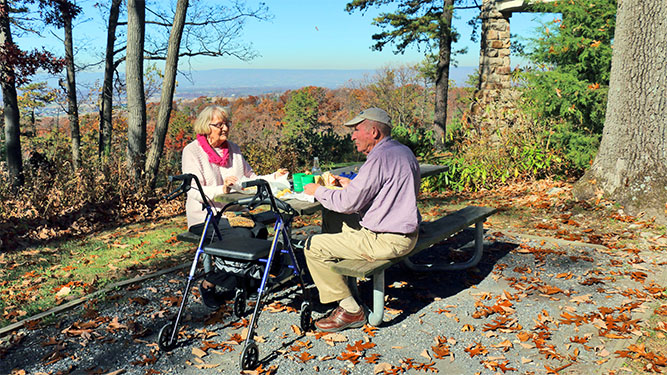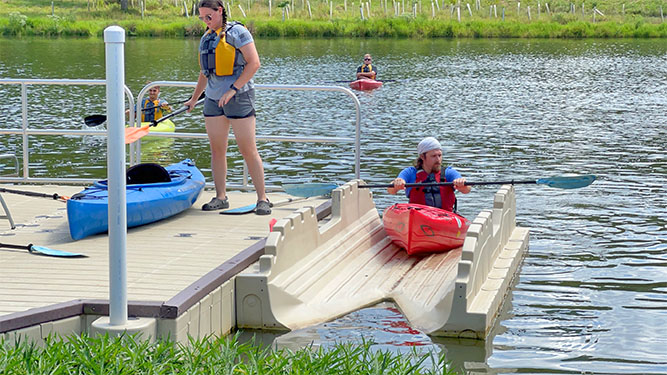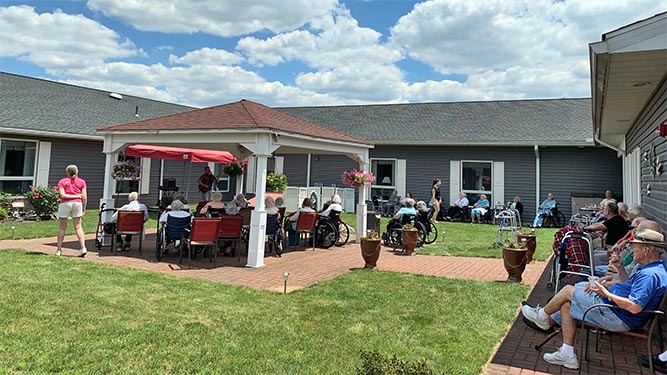Pennsylvania is the fifth most populous state in the nation, and it also has the fifth highest population of older adults at 3.4 million.
As the population of people over 65 continues to grow, it’s important for the Commonwealth to address the issues that impact this key group.
As a part of its core work to get Pennsylvanians outdoors and make the outdoors more accessible for all, the Department of Conservation and Natural Resources is working with partners to ensure older adults are getting essential time outdoors to boost their physical and mental health.
Time in Nature and Wellness

Here are 10 reasons why exposure to nature is so important:
- Spending time outdoors can improve the immune system.
- Nature can reduce stress and anxiety and improve mental health.
- Experiences in nature can help improve happiness and wellbeing.
- People who have access to nature have reduced diastolic blood pressure and heart rate.
- Spending time outdoors and in nature can increase energy levels.
- Experiences with nature can improve cognitive function.
- Older adults can improve memory and attention span by experiencing nature either through outdoor experiences or viewing pictures or videos.
- Having opportunities to enjoy nature helps adults live longer, more fulfilling lives.
- Exposure to green and natural environments can reduce the risk of chronic illnesses such cardiovascular disease and diabetes.
- Nature can give people a sense of meaning and purpose in life.
Many of these 10 benefits of connecting with nature apply to all people, but the truth of the matter is that not everyone has equitable access to the outdoors.
Older adults, specifically residents of long-term care facilities, often rely on visitors, staff, and volunteers to be able to spend time in the natural environment.
And while we have been working to make outdoor recreation more accessible through ADA accessible adaptations, there are still barriers to entry and use.
Accessible and Inclusive Recreation

The Department of Conservation and Natural Resources’ implementation of Pennsylvania’s statewide outdoor recreation plan --
Recreation for All -- prioritizes safe and welcoming access for all, while underscoring the connections between spending time in nature and health and wellness, including expanding ADA accessibility on public lands.
The department is working to:
- Strengthen connections with the health and wellness community
- Design and construct more ADA-accessible trails and parks
- Proactively engage and serve historically underserved populations through partnerships with outdoor and conservation non-profits, older adult advocates, and more
“We are very aware of the barriers and challenges many older adults and those with disabilities experience with having access to the outdoors,” Department of Conservation and Natural Resources Secretary Cindy Adams Dunn said. “The Shapiro Administration is committed to providing healthy, safe, and high-quality opportunities for older adults to get outside and enjoy the incredible benefits our natural spaces provide."
New Toolkit to Create Outdoor Connections for Older Adults

DCNR is working with the departments of Health and Aging to create a toolkit to highlight key resources that will help older adults and their caregivers plan and achieve successful nature-related activities.
Some examples include:
Bringing Nature Indoors: Imagery and sensory objects related to nature can be as beneficial sometimes as being outdoors, particularly for those who experience significant barriers with mobility, activity limitations, transportation, and access. Ideas covered in the toolkit include indoor gardening, wildlife viewing at bird feeders; and connecting to organizations that can provide educational programming.
Adapting Facilities: A variety of facility adaptations for residents’ access to the benefits of the outdoors can be completed at a low cost with a dedicated space and time for the projects. Suggestions are sensory rooms, butterfly gardens, and nature-themed murals.
Getting Older Adults Outdoors: For older adults experiencing social isolation, being outside with others provides socialization opportunities that can bring a renewed sense of joy and purpose.
Among the opportunities are a
Walk with a Doc program, connecting with
Penn State’s Master Gardener program, and finding accessible facilities to visit in state parks and forests.
Nature plays an essential role in maintaining wellness, but these benefits are lost on an underserved population of older adults due to circumstances beyond their control.
Look for the toolkit before the end of this year as another step to help ensure the outdoors are truly for all.